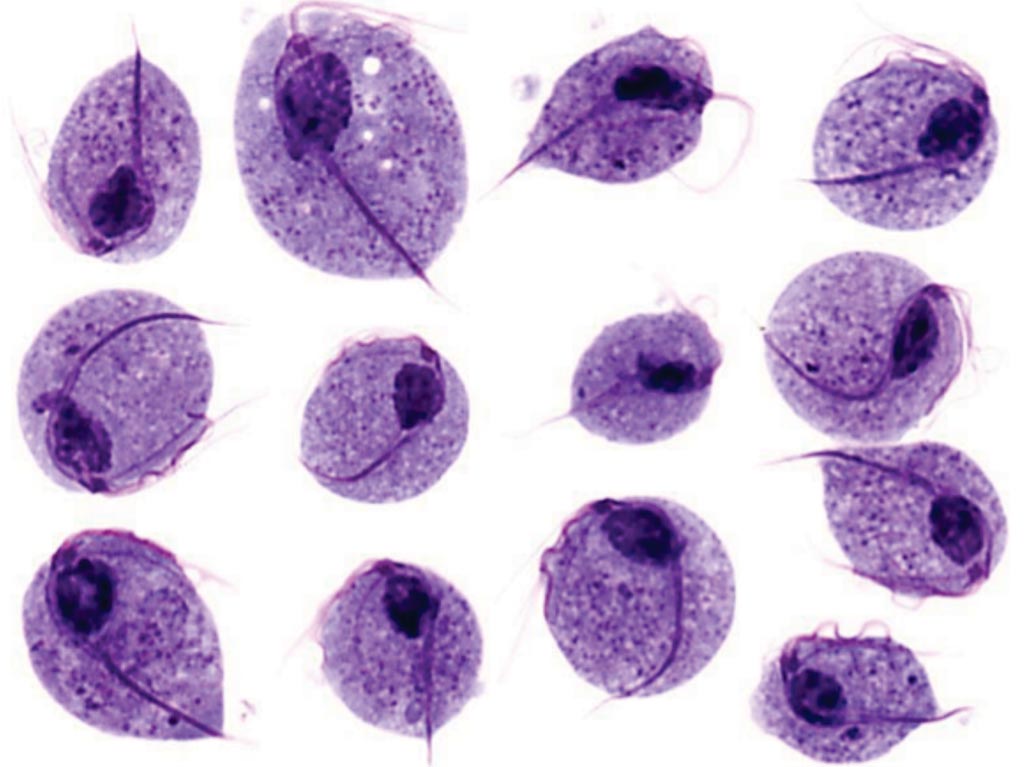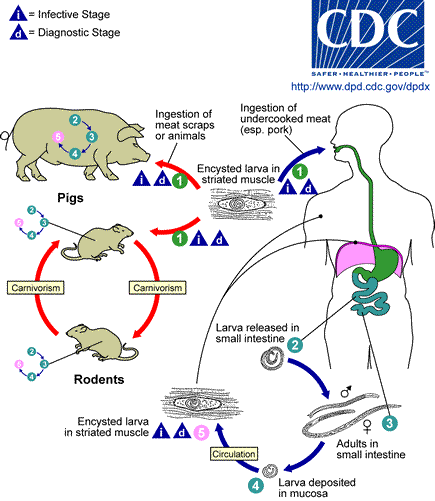Genus : Trichomonas
- Members of this genus have four anterior flagella, an undulating membrane but no trailing flagellum
- Trichomonas gallinae is of veterinary significance
Trichomonas gallinae
Location and host
- Occurs in upper digestive tract of pigeons, turkeys, and rarely chickens and other birds
Morphology
- Body is elongate, ellipsoidal or pyriform, measuring 5-19 x 2-9 µm
- Four anterior flagella are present arising from blepharoplast
- Undulating membrane do not reach the posterior end of body and free posterior flagellum is absent. Accessory filament is present.
- Axostyle is narrow, protrudes 2.8 µm from body, and its anterior position is flattened into spatulate capitulum
- Crescent shaped pelta is present just anterior to axostyle and there is no chromatic ring at its point of emergence
- Parabasal body is hook-shaped and has parabasal filament. Coasta is very fine rod running three quarter the length of the body.

Fig: Trichomonas gallinae
Life cycle
- Parasite reproduces by binary fission and has no cyst stage in its life cycle. Trophozoites must be transmitted to another susceptible host
- Birds gets infection through ingestion of contaminated feed and water
- After ingestion they reside in oesophagus , proventriculus, where they multiply rapidly by simple division (binary fission)

Pathogenesis
- Disease caused by this parasite is called avian trichomoniasis
- Early lesions in pharynx, oesophagus, crop are small whitish to yellowish caseous nodules. They grow in size, coalesce to form thick, caseous, necrotic masses that may occlude kimen.
- Lesion may remain circumscribed. These circumscribed disc-shaped lesion are often described as ‘yellow button’.
- Lesion in liver, lung and other organs are solid, yellowish, caseous nodules upto 1 cm or more in diameter.
Transmission
- Infected parent when feeds crop milk to young one
- Through contaminated drinking water
- When predators birds feeds on infected prey bird
Clinical signs
- Depression
- Ruffled feathers
- Weakness
- Emaciation
- Greenish fluid or cheesy material accumulation in mouth and crop
- Foul smell emitting from mouth
- Birds may have difficulty in swallowing and breathing
- Diarrhea may also occur
Diagnosis
- Clinical signs are pathognomonic
- Demonstration of motile trichomonads from samples taken from mouth confirms diagnosis
Treatment
- 2-amino-5-nitrothiazole (Enheptin @30-45 mg per day) for 7 days
- Metronidazole, dimetridazole is drug of choice. Treatment is successful after 1-2 days with early diagnosis
- Risk of uncontrolled bleeding, if oral plaques are removed by foreceps
- Furazolidone @ 25-30 mg per day for 7 days
Control
- Culling and treatment of infected birds
- Cleaning feeders and bird bath and leaving them dry for weeks help in decreasing spread of disease
- Prevention of access of wild pigeons to drinking water